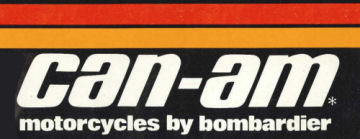


Section 5: Riding the bike Updated! |
The first test ride was done at Jim's
ranch in a large cow pasture. Not the best of locations to test a motorcycle, but it
gave us an idea of what the bike would do. We were impressed with the power
but really couldn't tell how it handled, or how the powerband worked under various
conditions. However, we were both very happy with the bike at the end of the first
ride.  The second time he rode the MX-1 was on a real motocross track. The track was a modern bike layout consisting of deep sand, large table tops and double jumps. It wasn't designed for a vintage motorcycle with 1974 suspension, but we figured if it worked on that kind of track it would certainly handle well on a track set up for vintage motocross. It wasn't a race day at the track and there were a few modern motorcycles out practicing. As soon as the CanAm was unloaded we drew a small crowd. Many comments were spoken, ranging from "WOW!," to suggestions that we should consider some type of therapy. It was kind of neat to attract so much attention! Jim was a little hesitant the first few laps to open it up. He's used to modern bikes and wasn't quite sure what would happen if he attacked a set of whoops or landed hard off a big jump. But in short time he was chasing the modern bikes and flying high. The steering on the bike is fantastic, and totally
uncharacteristic of the early MX1 and MX2 series CanAms. Jim quickly became
confident that it would go where he pointed and turn on command. The Progressive
Suspension shocks worked flawlessly. We set them up with 65 lb. springs on the 3rd
preload which worked well for the 200 lb. rider. The forks bottomed when he rode it
in the cow pasture so we purchased a set of HD springs from Matt at Speed & Sport to
stiffen it up. They still bottomed on the motocross track but only on hard landings
from big jumps. I would say that it was normal under those conditions. We used
20w fork oil which seems to provide appropriate dampening with the stiffer springs. Jim says that it will easily outrun his KLX 250, but he felt that it comes on the pipe a little too hard. It's difficult to say whether his experience with the 4-stroke has biased his perception of how a 125 should run, but the bike does explode pretty hard when it comes on the pipe. If he continues to have trouble adjusting to the powerband I may change the rotary valve and/or install the external flywheel Bosch ignition to mellow it out a bit. For anyone thinking about building a CanAm vintage racer, I now feel confident to recommend the suspension and frame modifications which have been documented in this article. The engine mods are something you need to experiment with for yourself. A stock TnT or MX1 125 engine will be competitive bone stock. If you want more horsepower like we did, you have to realize that adding horsepower always has its consequences. On a 125, putting more horsepower on top will always effect the powerband and bottom end. But if you are an old 125 racer who is accustomed to pipey Japanese motorcycles, the mods we did to the motor may fit your style quite well. See you at the races!
|